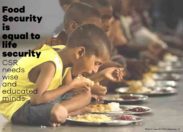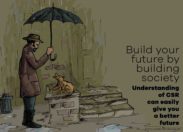Background Situation – Migration.
The concept of migration is as old as human civilization. People migrate from one place to another place because of economic, social, political reasons; search of employment, marital, educational and religious reasons. Migration is an integral part of tradition for some communities like Gijjar and Rewaries community.
Maharashtra being the most developed state in India provides a conducive environment for industry, transportation , better educational facilitates made available in the state and also good health related services. Hence, it is a hub of migration, for both inter and intra state. Inter state migrations are mostly semi-permanent or permanent in nature.
Migrations are seasonal in nature.
Seasonal employment provides livelihood to millions of poor in the state, especially in rural areas.
All of them search employment in the sector of construction such as labourer at brick making udyog, irrigated agriculture sector and most of them are engaged in sugarcane cutting. Migration therefore plays a pivotal role in the livelihood strategies of the rural poor.
Seasonal migration is become a general habit in Maharashtra. It has long history of labour mobility and labour migration from one place to other place. There are basically two categories of seasonal migrants. The first category consists of regular seasonal migrants who travel for work during the non-agricultural season. The second category consists of small and medium farmers who migrated to support their livelihoods as a consequence of agro-ecological crisis in the areas they live in. Though the percentage of regular seasonal labour is usually more in Maharashtra due to inadequate irrigation facilities ,nearly 5 to 6 lakh people migrate every year in the state, making the second category to be on the rise. Irrespective of these considerations, migration acts as a compensating mechanism to reduce the disadvantageous position of the poor.
The sugar factories in western Maharashtra, the brick kilns in Thane district, quarries in Ratnagiri and various construction sites are in Pune Mumbai, Thane, Nasik and other developed cities are main hubs for the centers of seasonal migrations. People from undeveloped villages who are prone to calamities, conditions and lack of employment opportunities outside the agricultural season, prefer migration.
Normally laborers migrate with their families. Women and children constitute a high proportion of the migrant population. The motive behind migrating with the family is obviously more employment, more earnings and family’s safety. To explain this with the help of an example , ‘when Mr. and Mrs. Migrated from their place, nobody was there to take care of their kids, hence they migrated with their families, and the elder kid may get employment along with his parent and is rendered another earning member for the family. According to statistics, Maharashtra occupies the third place in India in terms of child labour. Migration always involves too many working hours, poor standards of living and working conditions and less access to basic facilities like education, health, food distribution system, etc.
Seasonal Migration of Sugarcane cutters
India is the world’s largest sugar producer and Maharashtra is the country’s largest sugar producing state contributing over one-third of the country’s output. Maharashtra has approximately more than 300 sugar factories and, more than 2000 of Gul producers gurhals ( Gul making industry ). Whilst the Gul producing labour comes from UP, Bihar ,Uttaranchal, Uttarakhand and Karnataka. They live in temporary make shift hut with their family. Most of sugarcane factories are managed by cooperatives. Sugarcane farming was introduced in western Maharashtra by the pioneers of the co-operative movement during the 1950s. Since then it has progressed considerably and contributed exceedingly to the development of the rural infrastructure, economy and educational facilities.
According to official statistics issued by the Maharashtra State Sugar Cooperative Federation, 1.6 million farmers in the State cultivate sugarcane on 0.7 million hectares of land, producing 60 million tonnes of sugarcane. The sugar factories in the State have a combined turnover of about Rs. 8,000 crores and provide employment, directly or indirectly, to 1.5 crore people (Source :- Frontline).
Sugarcane is known as a lazy farmers crop since it does not require much care except watering at regular basis. On the other hand, sugarcane harvesting is a heavily labour engaged operation and thousands of laborers come from undeveloped villages, backward and drought prone areas to work as cane cutters. When all other options for livelihood are ceased, there is no alternative than to migrate to other areas for sustainable livelihood. Sugar factories in the western Maharashtra region and other part where sugar factories are established or situated provide an easy solution for them.
The sugarcane cutting and crushing season is normally operational from November to April/May. In these six-month duration, people from central Maharashtra and Marathwada region, (that are from backward and undeveloped, poor areas), migrate to the enriched sugarcane belt. A large majority of laborers come from Beed, Osmanabad, Jalgaon, Ahmednagar, Nashik, Jalna, Parbhani, Hingoli, Aurangabad, and Latur districts, all in the Marathawada region except Ahmednagar, Jalgaon and Nashik. Those families normally belong to the poorest families of society and are mostly landless or marginal farmers. Scarcity of resources and debt burden accompanied with dry spells of monsoon force people from these areas to migrate to nearby districts. Over 90% of sugarcane cutters belong to OBC, SC and ST categories. The remaining 10% consist of higher castes and Muslims. These laborers come through contractors/agents, popularly known as Mukadams appointed by the factory administration for smooth working . Contractors/Agents bring laborers in tolis or pathaks (a big group of laborers). Each pathak or toil have 25 to 90 and above laborers. The factory administration dept. and account dept. take care of advance payment for them. The advance amount is offset against their labour. If they are unable to pay off the advance money in a season, they have to go in for employment for another season or place.
Migrant laborers and their life – People come from other places come in search of employment that majorly constitute the migrant community. It is divided into 3 types The first consists of those who have their own a pair of bullocks and a cart and the second consists of those who do not. Those who do not have bullocks cart they, carry head loads of sugarcane to the roads from where it gets transported to the factory in vehicles like trucks, tractors and other vehicles. Those who have bullock carts, transport sugarcane to the factory directly. A third category of laborers are those who have their own bullocks but no cart. They are provided carts with rubber tyres, for carrying sugarcane up to the factory. But given all these 3 categories , the factory administration does not give them timely payment. Life for these migrant laborers is nothing short of destitute misery.
There are major issues like unavailability of on-site facilities for housing, lack of children’s education, lack of sanitation facilities and health concerns. Small zopadi (tents) made of bamboo and mats, that are given by factories, There is no Electricity supply in their area where 50 to 60 zopdies are made.Educational facilities for their children are conspicuous by their absence.
Much more hours of work, inadequate sleep, lack of proper food accompanied by poor hygiene and lack of sanitation facilities, water supplies at the site leads to poor health standards among the people.
Migration and its impact on child education
Bluntly, sugarcane has played a important role in bringing prosperity to the State and its people. However, hidden under this success are the lives of thousands of labouring families who have lost out on social, financial and educational development due to the seasonal and migratory nature of their work. Migration by triggering affects schooling of children and forces many children to work Dropping out from necessary schooling, children dropout from school percentage is very high and join their parents for a source of family income. It has been estimated that a staggering more than two lakh children of migrant sugarcane cutters, below 14 years of age, accompany their parents to districts all over the state, every cutting season. Over half of them, in the age group of 6-14 years (54% boys and 46% girls), totalling 1.30 lakh, end up being deprived of primary schooling. The reason is that there exists almost no provision to educate them at the destinations they reach (Source – Study conducted by the Centre for Development Research and Documentation – CDRD in April 2003).
The migration period is around 6 months i.e. November to April/May. This coincides with the second semester of the school in the State. As the first semester normally ends with the Diwali vacation and the second semester starts after the vacation.
Migrant children discontinue studies to be with their parents. In some cases, elder children who are studying and can look after themselves are left in the native villages. Younger children accompany parents since there is nobody at home to look after them. Due to long absences from school they fail to cope with the syllabus/studies. When they are back in their villages by the end of the sugar-harvesting season, either they appear for the final examinations and fail or do not appear and are therefore not promoted. Their interest level also goes down. Gradually they get dissociated from the education process and end up working as child laborers alongside their parents.
We lost our national wealth because of some short-term benefits. Off-course sugarcane industry have very important role in state economy but we take care about migrant peoples and provide them good facilities like health, sanitation, hygiene, water and education on site. It is very big challenge for us . But definitely we will solve this problem through take some initiate from CSR Programme.
jnicsr #jnicsrtimes #nikhilkumarsarojaz







4 Comments
รับแฮกไลน์
August 15, 2025 at 11:08 pm612265 927633Attractive part of content. I just stumbled upon your internet site and in accession capital to claim that I acquire in fact enjoyed account your weblog posts. Any way Ill be subscribing to your feeds and even I achievement you get entry to constantly rapidly. 430941
how to use casino bonus in mostbet
August 19, 2025 at 3:39 am609109 327112Rattling superb information can be located on internet weblog . 161409
วางระบบเน็ตเวิร์ค ระยอง
September 3, 2025 at 4:49 am68480 851495Water-resistant our wales in advance of when numerous planking. The particular wales surely are a selection of heavy duty snowboards that this height ones would be the same in principle as a new shell planking having said that with significantly far more height to assist you thrust outward in the evening planking. planking 499859
Villa for sale in phuket
September 13, 2025 at 10:05 am558476 359101Some truly nice and valuable information on this website, likewise I conceive the style holds excellent attributes. 836029